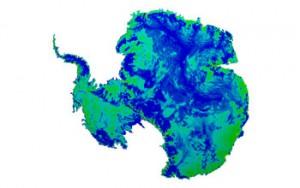CLOUD
UT Researcher Wins Grant to Study Uncertainty in Ice Sheet Models

The U.S. Department of Energy has awarded $2.85 million to mechanical engineering professor George Biros at The University of Texas at Austin to quantify uncertainties in large-scale computer simulations, including models of the melting Antarctic ice sheets.
Simulating complex natural or engineered systems to resemble reality can require billions of parameters “each of which can be uncertain,” Biros, a professor at the Institute for Computational Engineering and Sciences (ICES), said. “So estimating the overall uncertainty of the outcome can be quite challenging.”
Biros, a high-performance computing expert, will lead a team of researchers focusing on three specific systems of keen interest to the U.S. Department of Energy: the melting of continental ice sheets in Antarctica; complex fluid flows (such as what is observed in potential algae biofuels); and complex multiscale models.
These three systems are already the focus of three other ICES faculty members who will contribute: Omar Ghattas, who directs the ICES Center for Computational Geosciences and Optimization; Robert Moser, who directs the ICES Center for Predictive Engineering and Computational Sciences; and J. Tinsley Oden, who leads the ICES Multiscale Modeling Group and serves as the institute’s director.
In addition to the ICES researchers, Massachusetts Institute of Technology aeronautics and astronautics professor Youssef Marzouk will be contributing mathematical and algorithmic innovations in all areas, and Jeffrey Vetter, leader of the Future Technologies Group at Oak Ridge National Laboratory, will aid in scaling the new methodologies to supercomputers, such as those at UT’s Texas Advanced Computing Center.
“It’s a lot of effort just to run one simulation. It requires new algorithms and technologies,” said Biros. “So that’s why we need all this knowledge that has already been developed and can be applied to these uncertainty estimation techniques.”
The mathematical structure that defines simulations of physical systems is for the most part well known, Biros said. It’s the imprecise or unaccounted input values that cause uncertainty to arise. When dealing with large-scale simulations, even a relatively small number of unknowns can have significant effects on model accuracy as they propagate through the system.
A familiar example of the effects of uncertainty in simulation is the cone-like shape of predicted hurricane paths, Biros said.
“You typically see the cone opening as you look into the future,” Biros said, “which means whatever small perturbation that you have gets amplified so you’re more and more uncertain about the future.”
Currently, most uncertainty research has focused on small-scale systems with relatively few parameters using software that can be run on laptops. The algorithms and technologies that Biros is developing for complex systems, on the other hand, require the high-processing power of supercomputers.
Besides being directly related to energy applications and interest, the three systems also serve as models for many other complex systems, Biros said.
“There are many other problems founded by theory that have very similar structures,” Biros said. “We believe that if we are successful with these applications, this technology, with modifications, will be transferable to other systems.”
Biros is a two-time winner of supercomputing’s highest honor, the Gordon Bell Prize, awarded by the Association for Computing Machinery. He leads the ICES Parallel Algorithms for Data Analysis and Simulation Group, and holds the endowed position of W.A. “Tex” Moncrief, Jr. Simulation-Based Engineering and Sciences Chair II.
